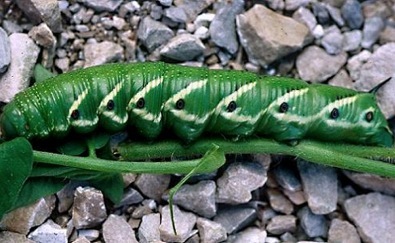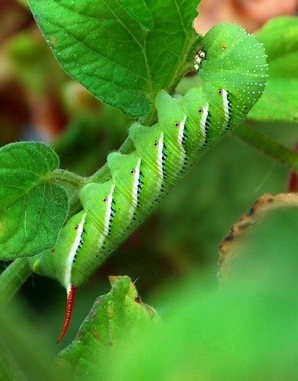
Tomato Horn Worm
Manduca Cuisine: Eating Green Gluttons
You’re picking tomatoes and suddenly there it is: Big, ugly and green, a tomato hornworm. To which I say, get or the frying pan., well, almost.

Tobacco Horn Worm
Up to four-inches long the worm has a horn on the back end. That and its stripes help you identify it because two big worms like your tomatoes. If it has chevrons and a black horn it is Manduca quinqueaculata, the Tomato Hornworm (above) If it has seven diagonal stripes and a red horn, it is Manduca sexta , or the Tobacco Hornworm (right). It would have been nice if they had called the one with the red horn the tomato one but they didn’t. Black horn = Tomato. Red horn = Tobacco. Numerous text and photo entries on the internet have them backwards.
The Tobacco Hornworm (red horn) is found chiefly in southern states, the Tomato Hornworm (black horn) in northern states but neither exclusively so. Both are edible after cleansing. Both are the larval stage of the hawk or sphinx moths and you can find both on the same plant. They are located on the outer areas of the plant at dawn and dusk, near the interior of the plant during the day. The larvae don’t like direct sun.
These hornworms feed only on Solanaceae plants, usually tomatoes or tobacco. However, larvae will also attack eggplant, pepper, and potato. There are many solonaceous weeds that also serve as hosts if tomatoes aren’t around including horsenettle, jimsonweed and various nightshades. Some of those are toxic. That is why you should keep the worm around for a few of days or more and feed it something wholesome (a bit of green pepper or red tomato) before cooking, or starve it for a couple of days until it offloads any toxic frass. Personally I would think twice about eating either hornworm that was found on tobacco. Nicotine is a powerful substance. It is also reduces clotting. Who knows, maybe dried Tobacco Hornworms who fed on tobacco can be used as a blood thinner should society fall apart.
As for the names, the genus Manduca (MAN-doo-ka) means “glutton” because these larvae eat a lot. Sexta means six-fold because the moth has six spots on its underside. Quinquemaculata (quin-cue-mah-cue-LAH-tah) means five spots because the moth has five spots on its underside.
Method of preparation; After purging, gently fried, sauteed if you will, or roast. Natives then strung them on a string and used them as a food necklace while traveling. If you want to raise them for food you can make them an artificial diet. There are several. Here is one:
Ingredients: One cup of non-toasted wheat germ, 1/3 cup non-fat dry milk, 4 tablespoons agar, one teaspoon raw non-boiled linseed oil, 1/2 tablespoon nutritional flake yeast, one 1000 mg vitamin C tablet, two vitamin B tablets, two multivitamin tablets, one tablespoon sugar, 2.5 cups of water.
Place vitamin tablets in a blender and reduce to a powder. Add the wheat germ, powdered milk and sugar. Blend until well-mixed. Remove the dry mix. To the blender add 2.5 cups of boiling water. While set on a low speed, add the agar. Blend for one minute then add the dry mix and mix. Add the linseed oil, increase blender speed and mix well.
If plain sauteing or roasting is not for you here is a recipe from David George Gordon’s “Eat-a-Bug Cookbook”.
3 tbs Olive Oil
16 Tomato Hornworms
16 Basil Leaves
4 Medium Green Tomatoes, 1/4″ Sliced
White Cornmeal
Salt and Pepper (to taste)
1) Lightly fry the Hornworms in a pan for a few minutes. Be careful not
to rupture the exoskeleton with the high heat (aesthetics). Set aside to drain
2) Sprinkle Tomato slices with salt and pepper then coat with cornmeal.
3) Fry Tomato slices on both sides until lightly brown.
4) Top each Tomato slice with one to two Hornworm. Top each Hornworm
with a Basil Leaf.


This afternoon we found 6 tobacco hornworms. Because of their incredible size we joked about eating them. I went along with this never thinking I would find information exactly how to fix them! Now I am tasked with preparing them – after we “purge” them! Too funny! Thanks for your “valuable” information. Yum!
Let me know… feeding them green pepper?
this links to a documentary called sex, drugs and plants, which is very interesting, and it mentions the way tobnacco plants call for help to fight the parasites that harm them. http://www.youtube.com/watch?v=aUZZkz70syE
The specific episode is: http://www.youtube.com/watch?v=Q53-18rDl4A&feature=relmfu
Eat the tomato worms with tomatoes? Oh the irony! LOL!
Forgot to say, thanks for posting this short how-to about eating them. Everything I’ve been clicking on so far was like, “Fried hornworms! Just kidding, har dee har! Ew!” and wasting my time.
Some friends and I ended up with an excessive amount of hornworms, for reptiles, already purged. Anyway we ate them sautéed, with butter and brown sugar, because we had read somewhere they tasted similar to shrimp. They weren’t great, nothing like shrimp, very chlorophyll tasting indeed. If we ever end up with excessive amount again, perhaps fried with some Louisiana hot sauce. The texture of them doesn’t allow for chopping. As soon as I get the video edited I’ll put it on YouTube for searching, because other videos about eating hornworms on there are just meh, no follow through.
It is dumb to have the parasitic wasp to kill the caterpillar, because the wasp will harm you also other is another way to save caterpillar is by using tweezers and taking the wasp eggs and putting them in a jar,then throw the jar away.
Picking & throwing the parasitic wasp eggs away is the dumbest idea ever. Parasitic wasps do not harm humans.
Parasitic wasps are not the stinging wasps you are thinking of. Parasitoid wasps are allies against crop damage. They do not sting people. They are an important part of the checks and balance of nature to keep caterpillars from taking over and eating all of the world’s vegetation.
I was kinda confused what do they eat both of the kind ?? Do they eat vegetables tomatoes and Spinach?
Feed the parasitic worms to the chickens
I came here to find out what they eat. Instead, I found out how to eat them. The internet is a weird, wild place.
Hello! I was wondering how you prepare them before cooking? Do you remove the horn, legs, etc. or just eat it as is? Thank you.
You have to eat them whole because they are full of chlorophyll water. The horn and legs don’t hurt anything. The skin is chewy and the insides very hydrating. If you chop them, you’ll explode them..
I ate one last year. It was very tasty… like a fritter-french fry. I would absolutely eat them again. Yeah… tastes nothing like seafood.
Made a funny video for YouTube too. Just search “Eats a hornworm”, or here’s the link…
https://youtu.be/f1_4uEaDsOo